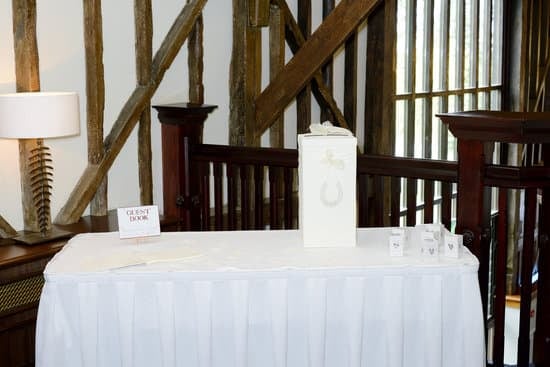How does a traditional wedding go? A traditional wedding is a significant event that holds deep cultural and religious importance in many communities around the world. It is a ceremony that symbolizes the union of two individuals, their families, and their communities. In this article, we will explore the various elements and rituals that make up a traditional wedding, from pre-wedding rituals to the modern twists that couples are adding to make their special day unique.
A traditional wedding typically involves a series of pre-wedding rituals such as engagement ceremonies, Mehendi (henna) application, Sangeet (music and dance), and Haldi (turmeric) ceremonies. These rituals vary across different cultures and regions but all play an integral part in preparing the bride and groom for their big day.
The choice of wedding venue is also an important aspect of a traditional wedding. From grand temples to lush garden settings or elegant banquet halls, the location sets the stage for the sacred ceremony. Additionally, the attire worn by the bride and groom is another crucial element of a traditional wedding, with intricate details and symbolism woven into every aspect of their clothing.
Pre-Wedding Rituals
Before the actual wedding ceremony takes place, traditional weddings often include a series of pre-wedding rituals that are meant to bring together the families of the bride and groom. These rituals vary from culture to culture but are often a way to celebrate and prepare for the upcoming nuptials.
Some common pre-wedding rituals include:
- Engagement Ceremony: This marks the formal announcement of the wedding and is often a small, intimate gathering of close family and friends.
- Mehendi Ceremony: This is a joyous occasion where the bride-to-be has intricate henna designs applied to her hands and feet. It is also an opportunity for music, dancing, and celebrating with loved ones.
- Sangeet Ceremony: Usually held on the eve of the wedding, this event includes singing, dancing, and performances by both families as they come together to celebrate the couple’s upcoming union.
- Haldi Ceremony: During this ritual, turmeric paste is applied to the bride and groom’s body as part of a beautification process. This ceremony signifies good luck and prosperity for the couple.
These pre-wedding rituals serve not only as a way to honor tradition but also as an opportunity for both families to come together in celebration before the wedding day. Each ceremony is rich with meaning and history that adds depth and significance to the overall wedding experience.
The next time you attend or participate in a traditional wedding, take note of these pre-wedding rituals as they play an essential role in setting the stage for how does a traditional wedding goes.
The Wedding Venue
Choosing the perfect wedding venue is a crucial aspect of planning a traditional wedding. The venue sets the tone for the entire ceremony and plays a significant role in creating a memorable experience for the couple and their guests. When it comes to traditional weddings, there are several factors to consider when selecting the ideal location for the ceremony. Here are some key considerations to keep in mind:
1. Cultural Significance: Many traditional weddings have cultural or religious significance attached to specific venues. For example, some couples may opt for a church, temple, or mosque depending on their faith and beliefs. It’s essential to choose a venue that honors and respects the cultural background of both the bride and groom.
2. Capacity and Amenities: The size of the venue should accommodate the number of guests expected to attend the wedding. Additionally, consider amenities such as dressing rooms, catering options, parking facilities, and accessibility for elderly or disabled guests.
3. Scenic Beauty: Whether it’s an outdoor garden, beachside location, or historical mansion, the aesthetic appeal of the venue adds to the overall ambiance of the wedding. Couples often seek picturesque backdrops for their traditional ceremonies, adding an element of beauty and romance to their special day.
4. Personal Connection: Some couples may have a personal connection to a specific location, such as a childhood home, family estate, or a place they hold dear to their hearts. Choosing such a venue can add sentimental value and memories that will last a lifetime.
When planning a traditional wedding, choosing the right venue involves careful consideration of cultural significance, capacity, aesthetics, and personal connections. Ultimately, the perfect location sets the stage for a beautiful celebration of love and unity.
Traditional Attire
The attire of the bride and groom is an integral part of a traditional wedding, often deeply rooted in cultural and religious significance. In many cultures, the wedding attire is more than just a garment; it is a symbol of tradition and heritage. For the bride, the wedding dress represents purity, modesty, and adherence to cultural norms, while for the groom, it may symbolize strength, honor, and prosperity.
In traditional weddings around the world, brides often wear elaborate gowns that are rich in symbolism and tradition. From the intricate embroidery on an Indian bridal saree to the flowing white gown in Western culture, each piece of attire carries its own unique significance. Similarly, grooms also don traditional outfits that embody the cultural values and customs of their heritage. This can range from a classic black tuxedo to vibrant ceremonial robes depending on the culture.
When it comes to accessories, brides often adorn themselves with jewelry that has been passed down through generations or holds sentimental value within their families. Grooms also wear specific accessories that hold symbolic meaning based on their cultural background. For example, in some Asian cultures, it’s common for grooms to wear special headgear or carry ceremonial swords as part of their wedding attire.
| Component | Description |
|---|---|
| Bridal Attire | Elaborate gowns or sarees with intricate embroidery; adorned with jewelry with sentimental value |
| Groom’s Attire | Ranges from classic tuxedos to vibrant ceremonial robes; may include specific accessories with symbolic meaning |
The Ceremony
A traditional wedding ceremony is a rich tapestry of rituals and customs, each with its own significance and symbolism. From the moment the bride and groom exchange vows to the post-wedding blessings, every step in the ceremony is steeped in tradition. Here’s a step-by-step breakdown of the rituals and customs involved in a traditional wedding.
Arrival of Baraat
The wedding ceremony typically begins with the arrival of the baraat – the groom’s wedding procession. Accompanied by friends and family, the groom makes a grand entrance to the beats of traditional music. This joyous procession sets the celebratory tone for the rest of the day.
Jaimala: Exchange of Garlands
Once the baraat arrives at the venue, there is an exchange of garlands between the bride and groom. This symbolic gesture signifies their acceptance of each other as life partners. The jaimala also serves as a formal introduction between the two families.
Saat Phere: The Seven Vows
One of the most sacred rituals in a traditional Hindu wedding is saat phere, where the couple takes seven rounds around a holy fire while making seven promises to each other. Each vow represents a commitment to love, cherish, and support one another through life’s ups and downs.
These are just a few highlights from a traditional wedding ceremony, showcasing centuries-old customs that continue to hold deep cultural significance. As times change and cultures evolve, modern couples are finding ways to infuse these timeless traditions with their own personal touches while honoring their heritage. Regardless of specific variations or regional differences, one thing remains constant – a traditional wedding is a beautiful celebration of love, unity, and tradition.
Reception and Banquet
In a traditional wedding, the reception and banquet are significant aspects of the post-wedding celebrations. After the exchange of vows at the ceremony, the newlyweds and their guests gather for a festive reception to commemorate the marriage. The reception typically includes music, dancing, and a grand feast, where family and friends come together to celebrate the union of the couple.
One key feature of the reception is the cutting of the wedding cake, which symbolizes prosperity and good fortune for the couple. Additionally, there may be toasts from loved ones, speeches from family members or close friends, and various forms of entertainment to delight the guests.
In some cultures, traditional dances or performances are also showcased during this part of the celebration. The reception serves as an opportunity for guests to offer their best wishes to the newlyweds while indulging in delectable food and drinks.
The feast that follows at the banquet is often an elaborate affair, featuring a wide array of dishes that hold cultural significance. From appetizers to main courses and desserts, each item on the menu may have symbolic meaning or be tied to customs specific to the couple’s heritage. The banquet represents not only a time for revelry but also an occasion for sharing culinary traditions with those in attendance.
| Aspect | Description |
|---|---|
| Wedding Cake | Serves as a symbol of prosperity and good fortune |
| Food Menu | An array of culturally significant dishes served at banquet |
Cultural Elements
Indian Weddings
In India, traditional weddings are a grand affair, often spanning several days and involving a multitude of rituals and ceremonies. From the vibrant colors of the bride’s saree to the intricate henna designs on her hands and feet, every aspect of an Indian wedding is steeped in tradition.
One of the most iconic traditions is the Baraat, where the groom arrives at the wedding venue on a decorated horse or elephant, accompanied by his family and friends dancing to lively music.
Chinese Weddings
Chinese weddings are full of customs symbolizing luck, happiness, and prosperity. The Tea Ceremony is a significant part of Chinese weddings where the couple serves tea to their parents as a sign of respect and gratitude. Red is considered a lucky color in Chinese culture, so it features prominently in the bride’s attire as well as in decorations at the wedding venue.
Another unique custom is the “crying marriage,” where the bride cries for one hour each day in the month leading up to her wedding. It’s meant to be an expression of joy.
Nigerian Weddings
Nigerian weddings are known for their festive atmosphere and rich cultural heritage. One popular tradition is the spraying of money during dance performances at the wedding reception, as a way to wish good fortune upon the couple. The Yoruba tribe, for example, has a custom called “Tying of Knot” which involves both families meeting to finalize marriage plans while praying for a successful union.
As we can see, traditional weddings vary significantly across different cultures and regions, each with its own unique customs and traditions that add depth and meaning to these joyous celebrations.
Modern Twists
In conclusion, the traditional wedding is a beautiful and culturally significant event that varies greatly depending on the region and culture. The pre-wedding rituals such as engagement, mehendi, sangeet, and haldi ceremonies set the stage for the grand celebration to come. These customs are followed by choosing the perfect wedding venue, where the intricate details of the bride and groom’s traditional attire take center stage.
The wedding ceremony itself involves a step-by-step breakdown of rituals and customs that have been passed down through generations, symbolizing love, unity, and blessings for the couple. After the ceremony comes the reception and banquet, where family and friends come together to celebrate with music, dance, and a sumptuous feast.
It is important to recognize that modern couples are now infusing their traditional weddings with personal touches and modern elements. Whether it be incorporating new music choices or adding contemporary decor to the traditional setting, couples are finding creative ways to honor their heritage while also making their special day uniquely their own. This blending of tradition with modernity ensures that these time-honored rituals remain relevant in today’s society while reflecting the couple’s individuality.
Frequently Asked Questions
How Does a Traditional Wedding Goes?
A traditional wedding typically begins with the exchange of vows and rings, followed by a reception where family and friends celebrate the newlyweds. It often includes cultural or religious customs, such as a special ceremony or traditional attire. The event usually involves music, dancing, and a multi-course meal.
What Are the Procedures for Traditional Wedding?
The procedures for a traditional wedding can vary widely depending on the culture or religion involved. Generally, the process involves securing a venue, obtaining any necessary permits or licenses, planning the ceremony and reception, selecting and sending invitations, arranging transportation, hiring vendors such as caterers and musicians, and ensuring that all guests are well cared for throughout the event.
What Are the Traditional Wedding Rules?
Traditional wedding rules may include specific dress codes for the bride and groom, expectations regarding guest behavior, customary rituals or ceremonies to be performed during the event, guidelines for gift-giving or monetary contributions from attendees, and other cultural or religious customs that must be observed.
These rules help to maintain the significance and solemnity of the occasion while respecting age-old traditions.

I have been involved in marriages for over 20 years helping couples and singles understand more about them.





